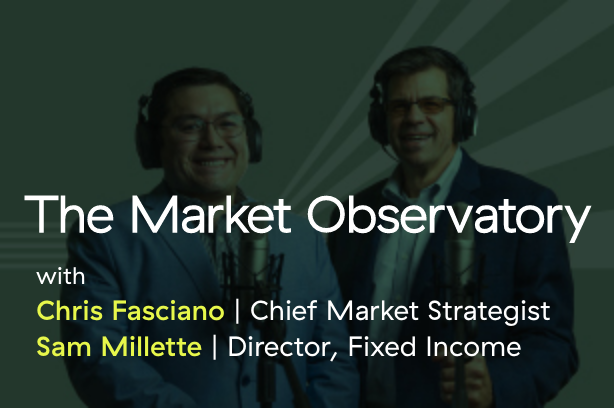 I spent my summers in a small Maine town where my mother grew up. In July and August, I was surrounded by relatives, playing whiffle ball and swimming. On the fourth of July, we would gather on my uncle’s lawn and watch the fireworks over the lake. As we reached the grand finale, we all waited for my aunt in the back to say, “Hooray for George Washington!” This has become part of our family’s fabric, passed on to the next generation. I treasure those memories and look forward to making new ones in the coming days. But before we all embark on our Independence Day holiday, let’s take a moment to reflect on what’s happening in the markets and what awaits us on the road ahead.
I spent my summers in a small Maine town where my mother grew up. In July and August, I was surrounded by relatives, playing whiffle ball and swimming. On the fourth of July, we would gather on my uncle’s lawn and watch the fireworks over the lake. As we reached the grand finale, we all waited for my aunt in the back to say, “Hooray for George Washington!” This has become part of our family’s fabric, passed on to the next generation. I treasure those memories and look forward to making new ones in the coming days. But before we all embark on our Independence Day holiday, let’s take a moment to reflect on what’s happening in the markets and what awaits us on the road ahead.
S&P 500 Reaches All-Time Highs
Despite the headwinds around trade policy, spending, taxes, and a slowing economy, the S&P 500 ended the first half of the year hovering around all-time highs. No doubt it was a rollercoaster ride to get there, with much volatility. After a busy six months, the fourth of July weekend gives us a chance to catch our breath, relax, and enjoy family and friends. When we return to our desks on Monday, it will be time to resume analyzing the issues that will determine the market trajectory in the second half of the year. Here is what we will be watching.
July 9 Looms
Next week will mark 90 days since the Liberation Day tariffs were put on hold. Recently, we’ve seen conflicting headlines on whether the pause will be extended to allow for continued negotiations or whether tariffs could resume if deals are not completed. We believe either outcome would eventually lead to trade deals being finalized, although the short-term impact on markets could differ.
Investors made it clear in March and April that they did not like tariffs or the accompanying uncertainty. Although there are ongoing issues regarding the future of global trade, it seems investors have confidence that these headlines are part of a negotiation process that will lead to deals that reduce or eliminate tariffs. Initially, however, an end to the pause could lead to weakness in equities.
Earnings Season Takes Center Stage
Continued earnings growth is key to providing a supportive backdrop for equity investors in the second half. First-quarter earnings for the S&P 500 surprised to the upside. Earnings growth came in at over 13 percent, double analysts’ expectations. This helped fuel the rally we have seen since late April. But corporate executives and analysts have tamped down expectations going forward. Expectations for second-quarter earnings growth stand at roughly 4 percent, down from over 10 percent at the start of the year and 7 percent at the start of the quarter. This trend is clear in the chart below.

As important as the actual earnings reports will be, commentary about the outlook for the second half is where we will focus. As seen above, analysts expect the rate of earnings growth to be higher for the third and fourth quarters of the year. Insights into the impact of tariffs will be a key focus, but plans for capital investment and hiring will also be worth paying attention to. These elements underpin continued economic growth. Investors will want some reassurance that the economy can continue to grow, even if slowly, and that earnings growth will be positive before the market shifts its attention to 2026.
The Fed Moves to the Front Burner?
Which brings us to the Fed. Chairman Jerome Powell has remained steadfast that the economic data doesn’t require the Fed to lower interest rates yet. This buys the Fed time to see if the impact from tariffs will show up in inflation data. Powell recently said that without tariffs, rates would already be lower.
The market and the Fed seem to be aligned that there will be two interest rate cuts in the back half of the year, with the most likely meetings for those adjustments taking place in September and December. Recently, some Fed members have begun to make the case for an interest rate reduction at the upcoming meeting at the end of this month. While job creation continues to be resilient, it is at a slower pace than last year. Combined with the impact of tariffs not yet showing up in the inflation prints, the data may finally be giving the Fed the support it is looking for to lower rates once again, beginning in the fall.
Initially, we anticipate that the market will respond favorably to lower rates. But over time, the question becomes why is the Fed reducing rates? Negative economic growth would lead to an earnings recession. And with markets at all-time highs and valuations extended, it could lead to volatility for equity investors.
Happy Independence Day
Given my childhood, I am partial to small-town celebrations filled with road races, parades, cookouts, and fireworks. But no matter where you spend the weekend or what your plans are, I hope you have great weather and an enjoyable few days. There will be time to get further clarity on the issues facing the stock market when we return and to determine whether portfolios are appropriately positioned to navigate the path forward.


 Print
Print

